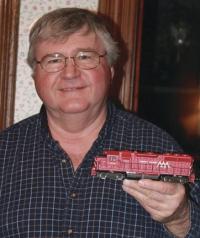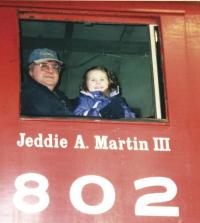
Serving the Vermont Champlain Valley Area for 45 Years
Main SectionsFront Page SportsValley VitalsIt's in the StarsStarwiseArchivesLinksAbout The VoiceContact Us |
Vermont Railroad And The Martin Family Heritage, Commitment And TransportationTuesday March 12, 2013 By Cookie Steponaitis The mystique and appeal of being on a train, moving across America and seeing the nation by rail was for many generations part of the American dream and is intertwined with the American heart and history. Not only did the railroad link two sides of the continent and pass through the vast American prairie lands and Rocky Mountains it also served as a testimony to our industrial age and American ingenuity. Everyday Vermonters can hear the whistle or see a train at a crossing, but few pay a thought to how much this institution has been and continues to be a part of American life even in 2013. In order to learn about the history of the Vermont Railroad there are books and then there are experts. And by expert this reporter means a family who has been working for the railroad for four generations. Jed Martin IV looks back at a family railroad heritage that begins with his grandfather Jed Martin II who was a bridge builder for what was then the Rutland Railroad. His son Jed Martin III was the Clerk Yard Master and held a variety of positions with the Rutland Railroad for twenty two years and then with the Vermont Railroad for an additional twenty two years ending his career as the Vice-President of Equipment. Jed Martin IV who is the source of information for this article ended his forty-four year career in 2008 and basically can attest to holding, “most all of the jobs available but ending his career as the Chief Mechanical Officer.” Continuing on with the Martin tradition Jed Martin V followed his father into the business and worked fourteen years as a clerk and car inspector and son Chris Martin worked eight years as a car man and painter of locomotives. Brother Paul Martin continues on the family story and is currently working in his forty-third year with the Railroad and is their Superintendent Motive Power and Chief Mechanical Officer. Sadly, Paul is set to retire in 2014. It was in the summer of 1967 when Jed Martin IV began his job with the Vermont Railroad. Jed, having been a part of the railroad through his father and grandfather had a clear understanding of what roles awaited him. Martin shared just a partial list of the positions involved with the running, maintaining and scheduling an organization the size of a railroad for Vermonters less familiar with the world of the train.“ Jobs, Wow!” remarked Martin, “now that is a loaded question. To name just a few, Vermont Railroad offers jobs including Engineer, Conductor, Brakeman, Trackmen, Machine Operators, mechanics, signal maintainers, Car Inspectors, Painters, Office Personnel, Dispatchers, Sales, Operations manager, Public Relations, Treasurers, President, Vice President, Superintendents, Carmen, Locomotive Hostlers, General Help and because of the nature of the industry most of these positions are learned with on the job training.” Throughout Jed’s career big changes have occurred at Vermont Railroad and their counterparts nationwide. While America still relies on the train system to move vast amounts of products daily the use of computers has changed how the cars and locomotives are tracked, monitored and controlled. “The electronics on locomotives are computer oriented more and more,” shared Jed. “We also have remote control units. One man has a control box and can switch out the whole train.” While the routes taken by the railroad remain virtually unchanged in over a hundred years, Jed sees the railroad transportation system growing and changing. He predicts that the future will bring more companies shipping by rail and states and the federal government will look to funding work on the road beds and rails. Trains run in all conditions and Jed himself has been part of crews that inspect the rails for water, washouts, and downed trees and has worked with plows to remove the snow which is pushed by the locomotives that have wings to push the snow back. Mostly the plows are needed for snowdrifts and blaze the tracks clear for the locomotive and the cars and huge loads being hauled behind. Jed looks back on his career not only with pride but with a sense of family and shared that it always amazed him how all the employees and different parts of the railroad worked together to get a job done taking pride and care in their efforts. Jed has traveled all over the United States and Canada by rail and spoke with great fondness about purchasing an old locomotive that was shipped to Burlington, Vermont. There Jed worked on rebuilding the unit from the ground up, painting it, lettering it and seeing it take its place in the line. If you are a driver stopped at a train crossing and watch locomotive 802 pass by, the name Martin will be on the side because Vermont Railroad dedicated it to Jed’s father. Jed Martin pointed out that railroads continue to grow and trains are getting larger because companies are hauling more freight. Trains run day and night, weekends and holidays and are convenient and expedient for companies shipping goods and services short or long distances. Most days, the trains seen passing by on the tracks in Addison County are headed between Rutland and Burlington or Burlington and Middlebury. Train crews today work a twelve hour shift and if the route is not completed for some reason a relief crew has to be sent in to get the train home which is a marked change from the 16-18 hour days that Martin worked when he first joined the Vermont Railroad. Another unique feature of the Vermont Railroad system is that employees do not have a union and most railroads today are union members. The history of this vital transportation network is available through several local authors and historians. Linking past, present and future, the story of the trains, like the story of the Martin family is one of proud traditions, incredible work ethic, and an understanding that America moves people and product through the trains, bringing communities and the continent to each other. The Valley Voice salutes the Martins.
|
AdvertisementsSearch our Archives |
Agricultural Weather Forecast:

© 2006-18 The Valley Voice • 656 Exchange St., Middlebury, VT 05753 • 802-388-6366 • 802-388-6368 (fax)
Valleywides: [email protected] • Classifieds: [email protected] • Info: [email protected]


 Printer Friendly
Printer Friendly